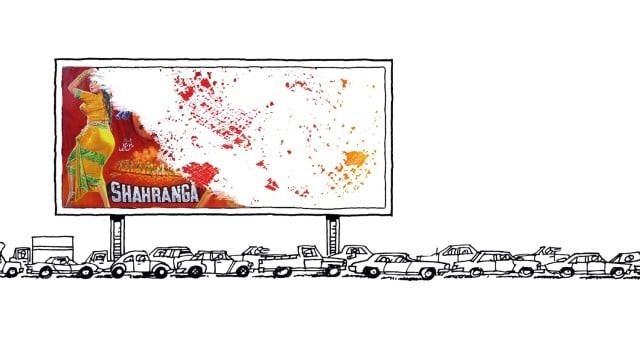
Mani represents the generation of artists who saw legendary artists working but never got a chance to be able to pass on the art of painting billboards to a younger generation.
When Mani had reached the peak of his career, digital images had started to replace handmade hoardings. This marks the same time that the number of Pakistani films being produced dropped dramatically.
Mani left the profession around eight years ago but still misses the days when he didn’t have time to take a day off as he had plenty of hoardings to work on and complete before a certain date.
Royal Park, a place in Lahore still known for the film business, used to have many workshops where seasoned commercial artists like S Rahi, M Younas, J Arfi, Sarwar and others worked and taught students, Mani explains. “There were a number of cinemas around the area of Royal Park. Some of them have turned into commercial theatres and others into parking lots or restaurants. 12 years ago, around 100 established artists were working on film hoardings and they had many students too but you can hardly find any such artists now,” he said.
The work of a film billboard artist is very different from a normal painter. The canvas for a film hoarding might be 200 feet in width and 40 feet in length. The painter divides his canvas into pieces and if he is supposed to paint a gun, he would paint it into three or four parts and then join them these parts on the board. “Sometimes we worked at a height of 20 feet to make a portrait. It’s a difficult job with very little room for mistakes. We worked on graphs to have an accurate idea of the space available. We would first make the rough sketches with pencil and then made colours from pigments and mixed varnish oil to make the colours bright and durable,” he said.
Mani said that artists often wondered how they worked. “Iqbal Haider sahib once asked me how do we manage such big canvas and I explained to him that how we do it with the help of graphs. He was delighted about it,” he said.
“When the film business went down, producers started saving money and then computers came to their help. They would get digital prints instead of paying money to the painter and would save time too. That is good but the beauty of a painting can never be imitated in digital photo,” Mani explained.
Gulzar, another former film billboard painter, said that when there wouldn’t be any movies there wouldn’t be any question of film hoarding artists. “Computers affected the painters’ job but it was more affected because the producers wanted to save money,” he said.
Zahid Akasi, a Lahore based senior film critic, believes that the downfall of Lollywood was bound to cause a snowball effect. “Painters are not the only people who quit their professions. Many other such professionals including cameramen, light men and others were unemployed. This is just a way to gauge that what film industry used to be and what it has turned into,” he said.
Published in the Express Tribune, June 10th, 2010.

















COMMENTS
Comments are moderated and generally will be posted if they are on-topic and not abusive.
For more information, please see our Comments FAQ